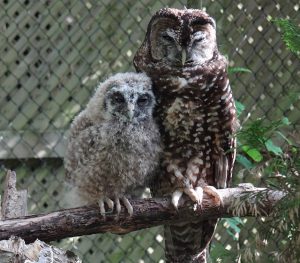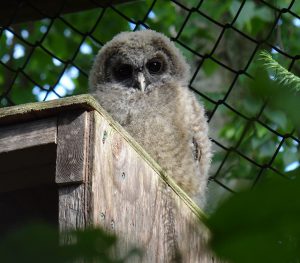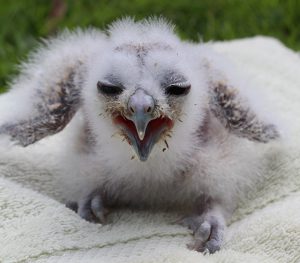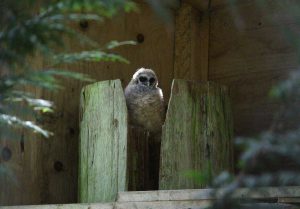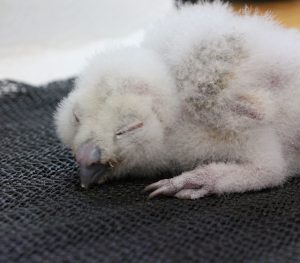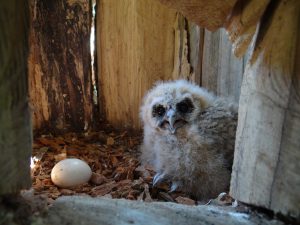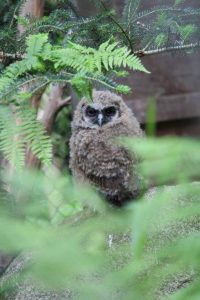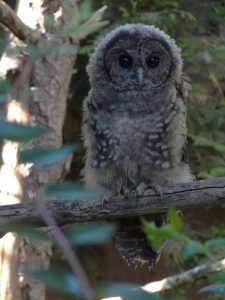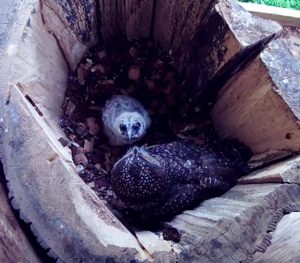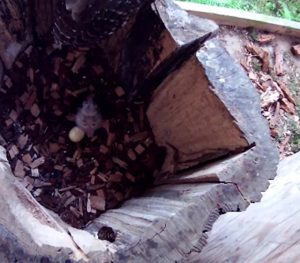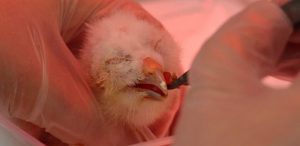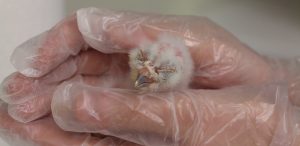Welcome to the northern spotted owl webcam
The northern spotted owl is one of Canada’s most endangered species with less than five wild individuals left in British Columbia. The webcam is brought to you by the FWCP and the Northern Spotted Owl Breeding Program (NSOBP). Watch Chick J-24 over the next few weeks before she leaves the nest.
Recovery of these endangered owls is one of the priority actions outlined in our Bridge-Seton Watershed Action Plan, and it is just one of 81 fish and wildlife projects the FWCP is funding, for approximately $8.7 million, in 2024–2025.
June 4, 2024: Chicks J-24 and G-24 have successfully fledged and left the nesting area. Foster parents Zalea and Einstein are continuing to be protective and caring, as the young pair explore the rest of the aviary and gear up for their first attempt at flight! Our northern spotted owl webcam is now closed for this year. Thanks for watching.
Zalea, Einstein, and two chicks!
Updated May 31, 2024: We are watching the same experienced foster parents as last year—Zalea and Einstein—raise two chicks! The parents, who bonded in 2019, have reared many chicks over the years and have the special distinction of being the first pair to raise two in one season at the breeding facility.
This year they started with raising Chick J-24, a female that hatched on April 29. She took 78 hours to hatch and went to Einstein and Zalea on May 14. A second chick was given to the foster parents on May 31. The second chick, G-24, is a male and a couple of weeks older than the female chick. His head has been coloured green with non-toxic marker to help tell the two chicks apart. As G-24 is older, he might do more exploring than J-24 and may not always been visible on camera.
Watch Zalea protect the nest and keep a close eye on the chicks until they are ready to fledge. Einstein’s primary role is bringing food to the nest. The best times for viewing are morning and evenings, but make sure you check out some nighttime activity as well.
A look back at 2023
On June 25, 2023, Chick T-23 hopped out of the nest for the very first time. At 34 days old, she was right on track in her development to leave the nest. This behaviour is known as “fledging” and she became fully independent by the end of the fall, when she moved to her own aviary with the hope that she might bond with a male and have offspring of her own one day.
May 2023 update: northern spotted owl recovery efforts
The Fish & Wildlife Compensation Program is saddened to hear the news that two owls released from the Northern Spotted Owl Recovery Program last summer were found dead earlier this month.
The NSOBP, Spuzzum First Nation, and the Ministry of Water, Land and Resource Stewardship issued the following press release on May 12, 2023:
https://news.gov.bc.ca/releases/2023WLRS0027-000729
We have been a long-time supporter of the Northern Spotted Owl Breeding Program (NSOBP) and our thoughts are with the entire team that is working towards the long-term goal of establishing a resilient and self-sustaining northern spotted owl population in B.C. The web-cam is not available at this time. Thank you for your patience.
Northern spotted owl facts
- The northern spotted owl is the rarest owl in Canada.
- It’s one of three sub-species of spotted owl.
- They prefer old-growth forests habitats.
- It’s among the largest owls in North America (40-48 cm long).
- It typically lays two to three eggs per clutch.
- It gets its name from the distinct spots on its head and back.
- The typical call is a four-note “who hoo hoo whoo.”
- Strix occidentalis caurina is the scientific name for this species.
- This captive breeding program is a critical part of the recovery effort of this owl in Canada.
- Chick B out the nest
- Chick B with foster dad Sedin
- Chick B out the nest
- Chick J May 4, 2020
- Chick F, June 2019
- Chick F, May 2019
- Chick B in nest mid-May 2018
- Chick B, Spring 2018
- Chick D, July 2017
- Webcam, 2017
- Webcam, 2017
- chick D, 2017
- Chick D, 2017
2022 northern spotted owls released into the wild for the first time
The conservation of endangered species in B.C. took a monumental step forward in August 2022 as three spotted owls born and raised in a breeding facility were released into protected habitat in the Fraser Canyon, which was the first release of these rare birds into the wild anywhere in the world.
This historic milestone was the result of a partnership between the provincial Spotted Owl Breeding and Release Program and the Spuzzum First Nation, with the ongoing support of the federal government, conservation organizations and other groups.
Prior to the release, there was only one known spotted owl left in the wild in B.C.
The northern spotted owl is one of Canada’s most endangered species. Recovery of these endangered owls is one of our priority actions outlined in our Bridge-Seton Watershed Action Plan, and it is one of 95 fish and wildlife projects the FWCP is funding, for approximately $9.8 million, in 2022–2023. The projects help to conserve and enhance fish and wildlife in watersheds impacted by BC Hydro dams. Learn more about why BC Hydro funds the FWCP.
FWCP and the Northern Spotted Owl Captive Breeding Program
One of the reasons the northern spotted owl is at risk in Canada is due to habitat loss resulting from a variety of human activities such as timber harvesting and human settlement, including the creation of reservoirs. That’s why FWCP is involved: our mission is to conserve and enhance fish and wildlife impacted by BC Hydro dams. In addition to funding the breeding program, the FWCP has also funded research and monitoring on northern spotted owls. Subscribe and stay informed about FWCP grants, and the projects we fund, including this one. If you have questions about the FWCP, please ask us: fwcp@bchydro.com.
The Northern Spotted Owl Captive Breeding Program’s objective is to release captive-raised owls into protected habitats, with the goal of establishing a viable self-sustaining population of spotted owls within the Lillooet area.
The Northern Spotted Owl Captive Breeding Program is funded by BC Hydro, the British Columbia Conservation Foundation, the Fish & Wildlife Compensation Program, INNERGEX, the Government of Canada, and the Province of B.C.
![]()
![]()
![]()
![]()
![]()
![]()




